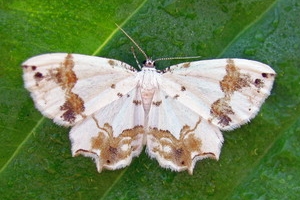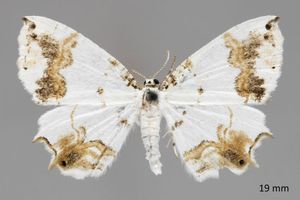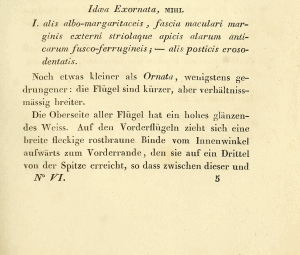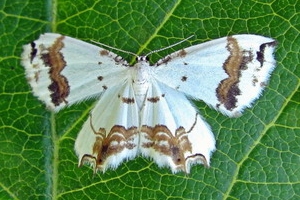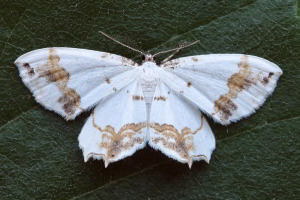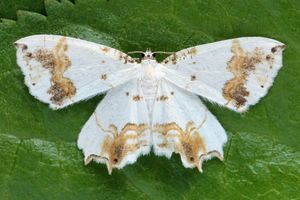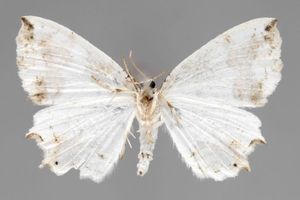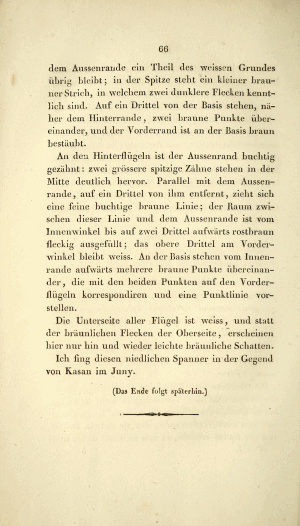

 +7Kontinente:EUAS
+7Kontinente:EUAS1. Lebendfotos
1.1. Falter
2. Diagnose
2.1. Geschlecht nicht bestimmt
2.2. Erstbeschreibung
3. Biologie
3.1. Lebensraum
Nach [http://www.chebucto.ns.ca/environment/NHR/lep_images.html#Epiplemidae] besiedelt die Art Moore mit Weiden (Salix), der (angeblichen?) Nahrungspflanze der Raupe. Die Falter sind nachtaktiv und ruhen tags unter den Blättern der Weiden. Sehr viel mehr Details dazu finden sich bei Dubatolov et al. (1994), die zu ihren Funden bei Novosibirsk berichten: " Since all the so far known findings of Eversmannia exornata concern imagines, the biology of the species in the considered region remain poorly studied. It is possible only to outline its flying period and to characterize its habitats based on the data from West Siberia. There the majority of the findings of imagines of this species happened in the interval June 20th - July 10th. They are always met with near rivers or small streams in wet meadow openings in woodland. The most abundant population was found out by O.E.Kosterin in a close vicinity of Novosibirsk Akademgorodok [Academy Town] in the valley of the Zyryanka stream. This habitat of E. exornata is described below in detail. [...] Firstly an individual of E. exornata was photographed (but not collected) on June 10th, 1981, on meadow vegetation near the thicket of willow trees 3-4 m high (several species, mostly Salix cinerea L., and also S. pyrolifolia Ledeb. and S. pentandra L.), which covering such a boggy part of the valley. On June 21th, 1992, seven imagines were found out in exactly the same very restricted (about 100 m long) section of the edge of the thicket. The neighbouring rich forb meadow, 5-10 m wide, covers the space of the valley bottom between the thickets and the southern slope, covered by open birch (Betula verrucosa Ehrh.) / asp (Populus tremula L.) forest with several individuals of Pinus Silvestris L. The moths were met with at this meadow within 3-6 metres of the willow bushes, some individuals penetrated 1-2 m under their canopy. They mostly sat on the underside of the leaves of Filipendula ulmaria (L.) Maxim. or other herbs (Fig.3). Disturbed, as a man came near, they easily got into the air, both in the middle of the sunny day, and in the cloudy dusk of this day. On 28th of June this locality was visited again, but only one individual of the species was observed."
3.2. Nahrung der Raupe
Noch völlig unklar! Auf [http://www.chebucto.ns.ca/environment/NHR/lep_images.html#Epiplemidae] ist zu lesen: "This species feeds on different species of willow (Salix) and is found in bogs. It is nocturnal and during the day rests on the underside of leaves, usually willows." Gleich mehrere Weiden-Arten - das klingt überzeugend; eine Quelle für die Behauptungen wird aber nicht genannt! Sohn & Yen (2005) führen uns auf die Spur: "Host plants: An unidentified species of Salix (Salicaceae) was reported to be the host plant from the European part of Russia (Dubatolov et al. 1994)." Die Lektüre von Dubatolov et al. (1994) ist dann aber ernüchternd: Sie hatten weder eine Raupe gefunden noch eine Eiablage beobachtet - das eben Geschilderte ist also nichts als blühende Phantasie! Dubatolov et al. (1994) fanden einige Falter mit einer gewissen Bindung an Weiden, mehr aber auch nicht! Zur Raupennahrung schrieben sie selbst: "The food plant species of the larvae of Eversmannia exornata is not known, but Viburnum has been reported as a food plant of some Japanese species of the genus. No individual of the guelder rose (Viburnum opulus L.), which is quite common in this zone, has been found in the site described. We failed to isolate any factor which could restrict the presence of Eversmannia exornata to this short section of the valley, since superficially the same conditions extend to a much longer distance along the stream." Von Salix als möglicher Raupennahrung ist nicht einmal die Rede!
(Autor: Erwin Rennwald)
4. Weitere Informationen
4.1. Andere Kombinationen
- Idaea exornata Eversmann, 1837 [Originalkombination]
- Epiplema exornata (Eversmann, 1837)
4.2. Locus typicus
Bei Eversmann (1837) ist zu lesen: "Ich fing diesen niedlichen Spanner in der Gegend von Kasan im Juny."
Dubatolov et al. (1994) schreiben dazu: "The only so far known Epiplemidae species inhabiting the West of Palearctic, Eversmannia exornata, was described by Eversmann [1837] as a Geometrid Idea [sic!] exornata from the surroundings of Kazan [Казань] (Tatarstan, Russia); this information was also reproduced in a later work [Eversmann, 1844]. There was no doubt in it among the researchers of the former century. Thus, this species was referenced exactly for Kazan' by M.A.Guenee [1857], while F.Walker [1861] mentioned it for South Russia. However, N. Erschoff [1870], for an unknown reason, had transformed the typical locality of this species into Kyakhta [Кяхта] (now - in South Buryatiya [Южная Бурятия]). This mistake was adopted by a great number of later catalogues, atlases and guides, such as O.Staudinger, M.Wocke [1971]; O.Staudinger, H.Rebel [1901]; A.Seitz [1913]; H.Inoue [1982]."
4.3. Faunistik
Nach der Zusammenstellung der Fauna Europaea [Fauna Europaea, lst update 29 August 2013, Version 2.6.2] ist die Art in Europa mittlerweile aus dem südlichen, dem zentralen und dem nordwestlichen Teil des europäischen Anteils von Russland, sowie aus Lettland und Estland bekannt. Auf der Seite [http://www.chebucto.ns.ca/environment/NHR/lep_images.html#Epiplemidae] ist zu erfahren, dass bis ca. 1980 nur eine Handvoll Angaben aus dem europäischen Teils von Russland bekannt waren, und dass es in den 15 Jahren danach eine deutliche Zunahme der Individuenzahlen und viele neue Meldungen gab, was wohl auf eine weitere Ausbreitung zurückzuführen ist. Basis hierfür war die Zusammenstellung von Dubatolov et al. (1994). Dort ist zu lesen: " So, the question arises where exactly is E. exornata distributed in West Palearctic?. In Europe, except for the typical locality of Kazan (the typical specimen, a female, with a label "Cas" written probably by E. Eversmann himself, is preserved in Zoological Institute of Russian Academy of Sciences, Sanct-Petersburg; its genitalia are shown in Fig.1), this species was known by a single specimen from Saratov Gubernie [Саратовская губерния] [Kroulikovsky, 1902]. Since "Kyakhta" is an erroneous locality resulting from Erschoff's [1870] transformation of "Kazan", we know the only reliable record of this species for Siberia: the Sayan Mts., where it was found out in the vicinity of the Tridtsatye ["30th"] Lakes [Тридцатые озера] in the middle reaches of the Kazyr [Казыр] river (the South of Krasnoyarsk Region [Красноярский Край - "Krasnoyarskii Krai"]) [Kozhantschikov, 1924]. These specimens were described as a distinct subspecies Epiplema exornata sibirica Kozhantschikov, 1924; that, to our mind, was not necessary. In 1980, while examining old untreated materials collected in various points of West Siberia, V.V.Dubatolov discovered the specimens of Eversmannia exornata originated from the western surroundings of Tomsk [Томск] and from the South-East of Novosibirsk Region [Новосибирская область]. Later, the species was found out in several localities near Novosibirsk, in Altai Region [Алтайский край - "Altaiskiy Kray"], in north-east of the Altai Mountains, and in Gornaya Shoriya [Горная Шория] (south of the Kemerovo Region [Кемеровская Область]). In recent decades, E. exornata was also re-discovered by collecting it in numerous sites in European Russia, namely, in Moskow, Ryazan, Ivanovo, Bryansk, and Tula Regions [Московская, Рязанская, Ивановская, Брянская и Тульская области]."
Talyak & Bolshakov (2008) stellen die Daten aus der russischen Oblast Nischni Nowgorod und darüber hinaus zusammen und nennen dabei - unter Verweis auf Solodovnikov et al. (2003) - auch den Nordosten von Weißrussland als Siedlungsgebiet der Art. Im Internet geistert auch eine Angabe aus der nördlichen Ukraine herum. Fest steht, dass die Art mittlerweile im Osten Europas etabliert ist. Solovyev et al. (2015) entwerfen eine Verbreitungskarte, die drei weit isolierte Zentren nennt; aus ihrer genetischen Studie leiten sie ab, dass diese drei Zentren erst im Holozän, vor ca. 5.000 Jahren entstanden, die Art sich also erst in geologisch junger Zeit ausbreitete.
4.4. Typenmaterial
Dubatolov et al. (1994) ermittelten: ""Cas" [Kazan], 1 ♀ - a type specimen, being kept in in Zoological Institute of Russian Academy of Sciences, Sanct-Petersburg."
(Autor: Erwin Rennwald)
4.5. Literatur
- Dubatolov, V.V., Antonova, E.M. & O.E. Kosterin (1994): Eversmannia exornata (Eversmann, 1837) - the only known representative of the Epiplemidae family (Lepidoptera) in West Palearctic. — Actias. Russian Journal for Scientific Lepidopterology, 1 (1-2): 19-23. [htm-Seite auf pisum.bionet.nsc.ru]
- Erstbeschreibung: Eversmann, E. (1837): Kurze Notizen ueber einige Schmetterlinge Russlands. — Bulletin de la Société impériale des naturalistes de Moscou 10 (6): 29-66.
- Sohn, J.-C. & S.-H. Yen (2005): A Taxonomic Revision of the Korean Epipleminae (Lepidoptera: Uraniidae), with Phylogenetic Comments on the Involved Genera. — Zoological Studies 44 (1): 44-70. [PDF auf zoolstud.sinica.edu.tw]
- Solovyev, V.I., Bogdanova, V.S., Dubatolov, V.V. & O.E. Kosterin (2015): Range of a Palearctic uraniid moth Eversmannia exornata (Lepidoptera: Uraniidae: Epipleminae) was split in the Holocene, as evaluated using histone H1 and COI genes with reference to the Beringian disjunction in the genus Oreta (Lepidoptera: Drepanidae). — Organisms Diversity and Evolution, 15 (2): 285–300. [PDF auf gfbs-home.de]
- Тальяк, Р. Е. & Л. В. Большаков (2008): Eversmannia exornata (Eversmann, 1837) (Lepidoptera: Epiplemidae) в Нижегородской области [Talyak, R. E. & L. V. Bolshakov (2008): Eversmannia exornata (Eversmann, 1837) (Lepidoptera: Epiplemidae) in the Nizhny Novgorod Province. — Eversmannia 15-16: 89. [PDF auf eversmannia.entomology.ru]







